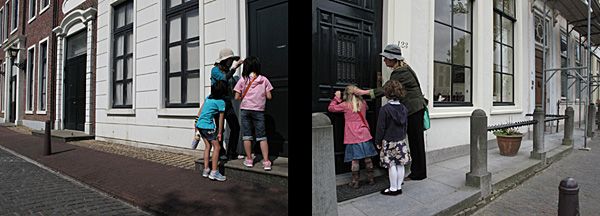See also Sven Lütticken, Idols of the Market: Modern Iconoclasm and the Fundamentalist Spectacle (Berlin: Sternberg Press, 2009).
“Liberal” in European politics is obviously not identical to the term’s usage in the US. The most basic principle of European liberal parties is “free market” politics, which may be combined with more or less progressive agendas. In the Netherlands, D66 (a party long held in favor by cultural bureaucrats) is in a sense the prototypical “third way” party, advocating liberal politics with a hint of social democracy, as well as more direct democracy and transparency. The VVD is essentially hardline market-fundamentalist, though some of the party’s positions on issues such as gay marriage would count as pinko subversion by US standards.
When presenting his election program, Wilders presented this list of left-wing hobbies: “Het kabinet moet fors gaan snijden in al die linkse hobby’s zoals de miljarden die worden uitgegeven aan de Europese Unie, ontwikkelingshulp, milieu- en kunstsubsidies, Vogelaarwijken, inburgering en ga zo maar door.” See Margreet Fogteloo, “Dag linkse hobby’s,” De Groene Amsterdammer, October 6, 2010, →. For a genealogy of the expression "linkse hobby," see →. During a parliamentary debate on culture on December 13, PVV parliamentarian Martin Bosma accused journalists of creating the false impression that the PVV considers art to be a left-wing hobby, claiming that it is instead the subsidizing of art that is the hobby in question. "Bosma: PVV vindt kunst geen linkse hobby" De Pers, December 13, 2010, →.
Hans den Hartog Jager, Dit is Nederland. In tachtig meesterwerken (Amsterdam: Athenaeum - Polak & Van Gennep, 2008). For Den Hartog Jager on Goldstein, see ‘Droomkandidaat’, NRC Handelsblad, July 10 2009; “Vernieuwd Stedelijk lost verwachtingen niet in,” NRC Handelsblad, August 27 2010.
René Pingen, Dat museum is een mijnheer. De geschiedenis van het Van Abbemuseum 1936-2003 (Amsterdam: Van Abbemuseum, 2005), 382; also 369–374.
Hans Haacke, Letter to Rudi Fuchs, July 27 1980, Van Abbemuseum archive. The letter was displayed in 2007 in one of the museum’s Living Archive presentations, ‘Wo stehst Du mit Deiner Kunst, Kollege?’
See for instance “Plans A to Z fail for DSB Bank,” NRC Handelsblad, October 19 2009, →.
“ABN Amro Secures Scheringa Museum Collection,” NRC Handelsblad, October 21 2009, →.
I know this inscription from a photo taken by Vivian Ziherl of De Appel's Curatorial Training Program.
A withering review by Camiel van Winkel was published in De Witte Raaf, no. 104, July-August 2003.
For a contextualization of Brinkman’s oft-quoted remark that art is the glijmiddel of the economy, see for instance →. After years spent as an influential lobbyist for the construction industry (see for instance →), Brinkman is becoming more active in the CDA again, vocally supporting the cabinet while complaining that its treatment of the arts is a bit “rough.” Brinkman is seen as being among a number of CDA grandees who want to win back terrain from the PVV by steering the party in a more conservative direction.
“Sponsors verdienen ook applaus,” Trouw, February 10 2009, →.
It should be noted, however, that the Gemeentemuseum occasionally puts on serious exhibitions of early twentieth-century artists, even if it does not manage to position them discursively.
Jonas Staal, "Post-Propaganda. Inleiding," in HTV De IJsberg no.82 (February–March 2010) →.
Tiers Bakker's response to Staal is at →.
Brian Holmes, “Extradisciplinary Investigations. Towards a New Critique of Institutions” (2007), →.
Hito Steyerl, “The new L-word is labour. Some thoughts on Peter Weiss and Auto-Kino!” (2010).
For practical reasons, the issue of the financial and ideological pressure brought to bear on Dutch universities – on faculties, staff and students alike, though in different ways – must fall outside the scope of this essay.
See also my essay “Acting on the Onmipresent Frontiers of Autonomy” in To The Arts, Citizens! (Porto: Serralves, 2010), 146–167, which grew out of my involvement in the Autonomy Project.
See →.
The VOC was the Dutch East India Company; in 2006, then Prime Minister Jan-Peter Balkenende lauded the enterprising “VOC mentality,” presenting it as a model for contemporary Holland for which he was rondly criticized because of the VOC’s role in colonizing and exploiting Indonesia.
See the comments on the website GeenStijl, owned by the newspaper De Telegraaf: →.
“Sinterklaas heeft wind in de zeilen,” Metro, December 11, 2010, →.
The Populist Imagination, Open no. 20, (2010).
